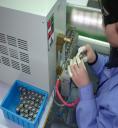Mar
20
Coming Soon to an Electrical Device Important to You
March 20, 2008 | 6 Comments
Nickel Zinc (NiZn) battery chemistry has met the European Union’s requirements for the Reductions of Hazardous Substances and 2006 Battery Directive as proposed by the U.S. company PowerGenix of San Diego, CA.
NiZn is a chemistry discovered by Thomas Edison and developed by an Irish chemist, Dr James J. Drumm that first saw use in 1932 in a light rail system. For years the NiZn chemistry has been considered a coming high technology addition to the battery chemistry race. With much higher energy to weight ratio than lead acid at 25% of the weight for the same power and a lower production cost than nickel cadmium the cost projections look to be between the lead acid and nickel cadmium prices.
The breakthrough that PowerGenix offers is in the early problems of the zinc fraction growing dendrites that would short circuit the cells. PowerGenix has taken a chemical approach that reduces the solubility of the zinc into the electrolyte solution reducing the material available for dendrite growth. With patent in hand for the chemistry innovation PowerGenix has added other enhancements in the cathode and anodes which are freed of heavy metal elements. These developments offer a much increased total cycling of charges and discharges making NiZn a very attractive option for rechargeable battery applications on scales as large as heavy equipment.
For comparison, NiZn carries 60Wh/kg vs. about 39Wh/kg for nickel cadmium and nickel-metal-hydride. NiZn also offers a very wide operating temperature range of –20 to +60 degrees centigrade.
Add to that the safety, environmental cleanliness and full recycling and absence of heavy metals there is a very good technology to face off with Lithium –Ion technology. One last bit should be quite important, NiZn runs about 0.4 volts higher than its competitors.
PowerGenix, started in 2000 has taken three financing rounds totaling $30.8 million and has production lines ready in China where existing nickel cadmium production is being displaced.
Dan Squiller, CEO of PowerGenix offers other insights. Nickel-metal-hydride was meant to solve the problem that early NiZn had with dendrite formation. NiZn outperforms nickel-metal-hydride by 30% at 20% less cost. Cadmium in nickel cadmium batteries deposit 30 million pounds of chemically active cadmium in U.S. landfills even though consumers pay a remediation fee at purchase. NiZn recycling is 10% of the costs for nickel cadmium recycling.
A battery powered hand tool that currently has nickel cadmium battery packs at 18 volts would have these differences with nickel-zinc batteries:
- Increased voltage to 24 volts
- 25% fewer cells in the pack
- Torque increased by 10% from lower pack impedance
- The pack volume will be 33% smaller and 35% less heavy
- An increased “mean time before failure” due to lower the cell count and interconnections
The milestone achieved by PowerGenix is significant. Breaking through the EU’s regulatory framework is a true achievement that signals that the technology is safer beyond the world’s highest standard.
The next test for PowerGenix is the board of directors and executive management choices that determine the availability by licensed production of their innovations and development prowess. Batteries are a huge worldwide business that can use a shot of growth that offers not just the manufacturing and sales revenues but will bring a recycling industry too.
NiZn is very attractive because the main chemicals, nickel and zinc are comparatively abundant. The recycling aspect is driven due to the substantial savings that accrue when near ready chemistry is remanufactured into fresh batteries compared to sourcing, mining, refining and chemical preparation of elements for battery use. The recycling process can be repeated without limit, as the use and remanufacturing process do not change the physical properties of the nickel or zinc.
But PowerGenix isn’t alone. A quick Google search will show that several companies are in the hunt with assorted technologies to solve the issue of low charge /discharge cycles. One thing is now certain. A benign, clean and endlessly recyclable solution is at hand now and will grow – perhaps into a tool or car near you soon.
Comments
6 Comments so far



[…] to be the choice for longer ranges and higher performance. Next on the list will likely be the Nickel-Zinc that is at this date still in the earliest stage of technology innovation for automotive…. With a good energy to weight ratio, increasing charge-discharge cycles and low cost recycling […]
You guys should be talking to Vectrix. Their highway electric scooter range needs to be improved to 60-70 miles. Some owners state their range is about 39 miles with real world conditions. Their current scooter is very heavy mostly due to the batteries.
This well written post assited me very much! Bookmarked the blog, extremely interesting topics just about everywhere that I see here! I like the info, thank you.
The nice article encouraged me very much! Saved the site, very interesting topics just about everywhere that I see here! I like the information, thanks.
Helpful post, saved the blog for interest to read more information!
If you could e-mail me with a few suggestions on just how you made your blog look this excellent, I would be grateful.